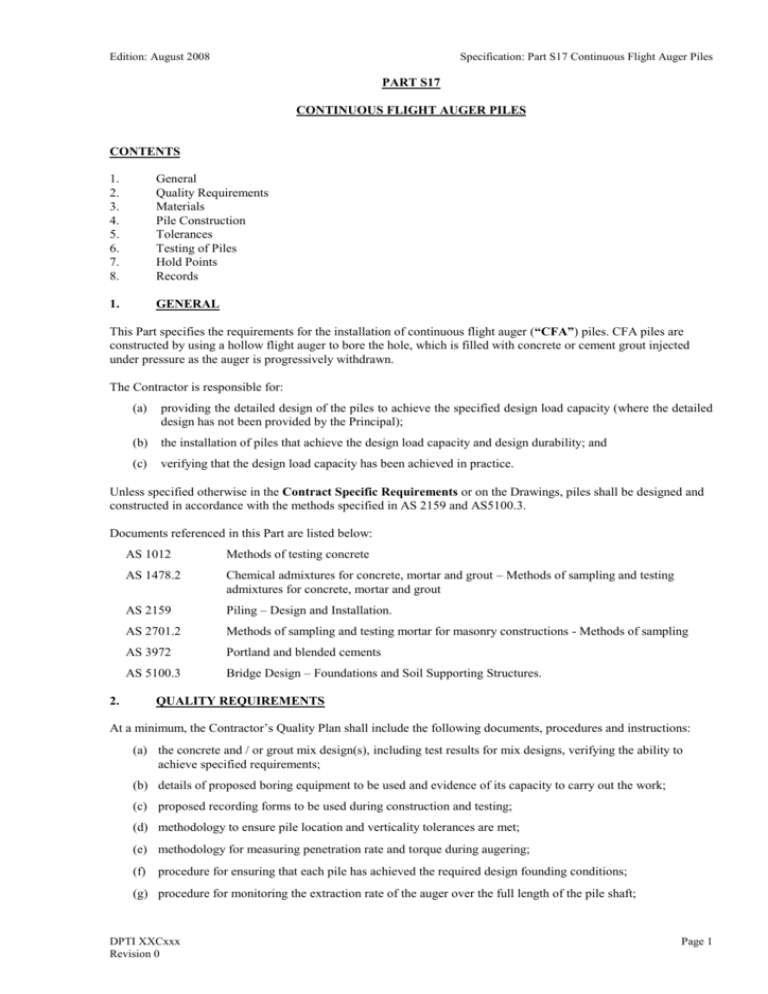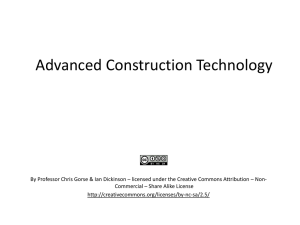Part S17 Continuous Flight Auger Piles
advertisement

Edition: August 2008 Specification: Part S17 Continuous Flight Auger Piles PART S17 CONTINUOUS FLIGHT AUGER PILES CONTENTS 1. 2. 3. 4. 5. 6. 7. 8. General Quality Requirements Materials Pile Construction Tolerances Testing of Piles Hold Points Records 1. GENERAL This Part specifies the requirements for the installation of continuous flight auger (“CFA”) piles. CFA piles are constructed by using a hollow flight auger to bore the hole, which is filled with concrete or cement grout injected under pressure as the auger is progressively withdrawn. The Contractor is responsible for: (a) providing the detailed design of the piles to achieve the specified design load capacity (where the detailed design has not been provided by the Principal); (b) the installation of piles that achieve the design load capacity and design durability; and (c) verifying that the design load capacity has been achieved in practice. Unless specified otherwise in the Contract Specific Requirements or on the Drawings, piles shall be designed and constructed in accordance with the methods specified in AS 2159 and AS5100.3. Documents referenced in this Part are listed below: 2. AS 1012 Methods of testing concrete AS 1478.2 Chemical admixtures for concrete, mortar and grout – Methods of sampling and testing admixtures for concrete, mortar and grout AS 2159 Piling – Design and Installation. AS 2701.2 Methods of sampling and testing mortar for masonry constructions - Methods of sampling AS 3972 Portland and blended cements AS 5100.3 Bridge Design – Foundations and Soil Supporting Structures. QUALITY REQUIREMENTS At a minimum, the Contractor’s Quality Plan shall include the following documents, procedures and instructions: (a) the concrete and / or grout mix design(s), including test results for mix designs, verifying the ability to achieve specified requirements; (b) details of proposed boring equipment to be used and evidence of its capacity to carry out the work; (c) proposed recording forms to be used during construction and testing; (d) methodology to ensure pile location and verticality tolerances are met; (e) methodology for measuring penetration rate and torque during augering; (f) procedure for ensuring that each pile has achieved the required design founding conditions; (g) procedure for monitoring the extraction rate of the auger over the full length of the pile shaft; DPTI XXCxxx Revision 0 Page 1 Edition: August 2008 Specification: Part S17 Continuous Flight Auger Piles (h) procedure for measurement and monitoring of pressure in the delivery line to ensure that positive pressure is maintained at all times during concreting or grouting; (i) methodology and equipment to provide a continuous record of concrete or grout flow rate and auger extraction rate to ensure that no section of pile contains less than the theoretical volume of concrete or grout; (j) the corrective action procedure to be taken if supply pressure and/or flow rate is not maintained during concreting or grouting, or the construction process is interrupted; (k) procedure for installation of the reinforcement cage, including spacer details and fixing and the method of ensuring minimum cover to reinforcement; (l) method of cutting and breaking back of piles; and (m) details of the proposed integrity test and load test methods, including the name and qualifications of any specialist sub-contractors and a method statement of how the test will be carried out and details of the record sheets proposed for monitoring results. If not provided beforehand, the documentation shall be submitted at least 28 days prior to the commencement of piling works. Provision of the documentation listed in this Clause shall constitute a HOLD POINT. 3. MATERIALS Concrete shall be in accordance with Part CC20 "Supply of Concrete". Reinforcement shall be in accordance with Part 305 "Steel Reinforcement". Longitudinal reinforcement shall be supplied in full lengths. Grout shall consist of cement, water and an admixture to reduce shrinkage and bleeding. Cement shall conform to the requirements of AS 3972 for normal Portland cement and shall be free from calcium chloride. Admixtures shall not contain chlorides, nitrates or similar electrolytic conducting materials and shall only be used where they will increase workability or reduce shrinkage and bleeding. The design strength of grout piles shall be calculated using the additional strength reduction factors given in AS 2159 and based on the suitability of the grout mix for the soil conditions. 4. PILE CONSTRUCTION 4.1 Protection of Adjacent Piles or structures The Contractor shall: 4.2 (a) minimise vibration during construction; (b) ensure that services, adjacent structures or newly cast piles are not damaged during pile construction; (c) not commence pile construction within 2.0 metres clear distance of a newly cast pile (or within three pile diameters, whichever is the greater) until the concrete or grout in the pile has attained a strength of 15 MPa; and (d) locate construction equipment at sufficient distance from the pile being drilled and from recently constructed piles to avoid displacement of the column of concrete or grout. Pile Construction Each pile shall be augered to allow construction of the pile to the size, position and level shown on the drawings. When the auger has reached the design toe level the foundation material shall be confirmed in accordance with the Contractor’s installation procedure, including reference to soils data, penetration rate of the auger and torque, or the toe level adjusted in accordance with the design requirements. DPTI XXCxxx Revision 0 Page 2 Edition: August 2008 Specification: Part S17 Continuous Flight Auger Piles Where piles are founded on rock, they shall extend the specified minimum distance into rock of the type and quality shown on the drawings. Pile shafts shall be formed by injecting concrete or grout in an uninterrupted operation as the auger is extracted. The method of maintaining positive pressure in the pumping equipment, and the method of maintaining an oversupply rate for concrete or grout shall be in accordance with the Contractor’s installation procedure. Care shall be taken to prevent earth and rock dislodging from the side of the hole or from the ground around the top of the pile and contaminating the concrete or grout and reducing the minimum cover to reinforcement. A minimum of 400 mm of sound concrete or grout shall be constructed above the final level of the pile. Any space between the top of the pile and the ground surface shall be filled with sand within 30 minutes of placing the shaft concrete or grout. Piles shall not be trimmed earlier than 24 hours after casting the concrete or grout. 4.3 Sampling and Testing Concrete shall be sampled and tested in accordance with Part CC20 “Supply of Concrete”. Grout shall be sampled from each truckload of grout supplied during pile installation. Cube samples of grout shall be taken in accordance with AS 2701.2 and shall be tested in accordance with AS 1012 to determine the compressive strength. Bleeding shall be tested in accordance with the requirements of AS 1478.2, and shall not exceed 2% of the volume three hours after mixing and shall not exceed 4% of the volume at any time. All separated water shall be reabsorbed within 24 hours. Shrinkage shall not exceed 750 microstrain. 5. TOLERANCES The following tolerances shall apply to completed piles: (a) pile head shall finish within 75 mm of the specified plan position; (b) variation from the vertical shall not be more than 1 in 50; and (c) minimum cover to reinforcement shall be 75 mm. 6. TESTING OF PILES 6.1 Integrity Testing Integrity testing shall be carried out on the piles in accordance with integrity test methods specified in AS 2159. Integrity testing equipment shall be capable of checking cross-sectional irregularities in piles and identifying the location and characteristics of any significant anomalies such as voids or contaminants. Acceptance criteria, supervision and reporting of integrity testing shall be in accordance with the requirements of AS 2159. Unless specified otherwise, integrity testing shall be carried out on all piles. 6.2 Load testing The Contractor shall carry out dynamic testing of piles to confirm that design pile capacity has been achieved. At least one dynamic load test shall be performed for every 30 piles. Additional dynamic load testing shall also be carried out on piles in the event that pile toe levels vary by more than 2 metres from the test pile. Testing shall be carried out by use of a Pile Driving Analyser (PDA) and the data obtained from each pile shall be analysed using CAPWAP, TNOWAVE or other approved equivalent software. Additional load testing requirements (including static load tests) may be specified in the Contract Specific Requirements or on the Drawings. The test procedure and test reports shall conform with the requirements of AS 2159, and two copies of a report showing the measured field parameters and the results of analysis to determine pile capacity shall be provided to the Superintendent. DPTI XXCxxx Revision 0 Page 3 Edition: August 2008 Specification: Part S17 Continuous Flight Auger Piles The measured ultimate capacity of test piles shall be equal to or greater than the pile test load specified in the Contract Specific Requirements or on the Drawings. 6.3 Test Results Submission of the test results shall constitute a HOLD POINT. 7. HOLD POINTS The following is a summary of Hold Points referenced in this Part: CLAUSE REF. 2 Submission of Quality Documentation 6.3 8. RESPONSE TIME HOLD POINT Submission of test results following the installation of a group of piles 14 working days 6 hours RECORDS The Contractor shall provide continuous records for each pile. The data recorded shall include the following: (a) Diameter, length, location and type of pile and date of boring; (b) Concrete or grout batch details, properties and slump; (c) Data recorded during installation of piles as specified in the Quality Plan; (d) All information regarding obstructions, delays and other interruptions to the sequence of work; (e) Integrity testing results; and (f) Load testing results. ____________ DPTI XXCxxx Revision 0 Page 4 DPTI XXCxxx Revision 0 Page 5





